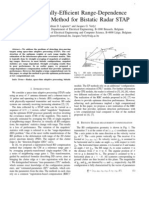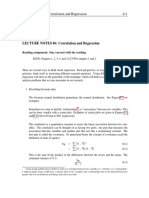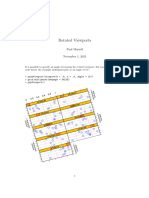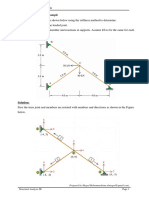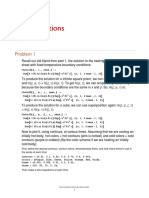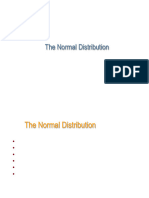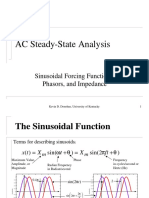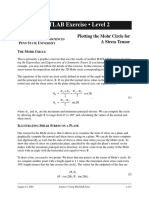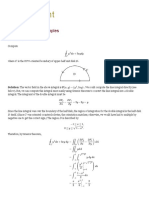Introduction To Vector and Matrix Norms: Department of Mathematics
Introduction To Vector and Matrix Norms: Department of Mathematics
Uploaded by
Rajeev GhoshCopyright:
Available Formats
Introduction To Vector and Matrix Norms: Department of Mathematics
Introduction To Vector and Matrix Norms: Department of Mathematics
Uploaded by
Rajeev GhoshOriginal Title
Copyright
Available Formats
Share this document
Did you find this document useful?
Is this content inappropriate?
Copyright:
Available Formats
Introduction To Vector and Matrix Norms: Department of Mathematics
Introduction To Vector and Matrix Norms: Department of Mathematics
Uploaded by
Rajeev GhoshCopyright:
Available Formats
Introduction to vector and matrix norms
Department of Mathematics
Boise State University
March 9, 2018
Math 365 Vector and Matrix Norms March 9, 2018 1/9
Vector norms
A vector norm is a scalar quantity that reflects the “size” of a
vector x.
The norm of a vector x is denoted as kxk.
There are many ways to define the size of a vector. If x ∈ Rn , the
three most popular are
n
X
one-norm : kxk1 = |xk |,
k=1
v
u n
uX
two-norm : kxk2 = t |xk |2 ,
k=1
∞-norm : kxk∞ = max |xk |
1≤k≤n
Math 365 Vector and Matrix Norms March 9, 2018 2/9
Vector norms
However a vector norm is defined, it must satisfy the following three
properties to be called a norm:
1 kxk ≥ 0 and kxk = 0 if and only if x = 0 (i.e. x contains all zeros
as its entries).
2 kαxk = |α|kxk, for any constant α.
3 kx + yk ≤ kxk + kyk, where y ∈ Rn . This is called the triangle
inequality.
Math 365 Vector and Matrix Norms March 9, 2018 3/9
Unit vectors
A vector x is called a unit vector if its norm is one, i.e. kxk = 1.
Unit vectors will be different depending on the norm applied.
Below are several unit vectors in the one, two, and ∞ norms for
x ∈ R2 .
U n i t v e c t or s w i t h r e sp e c t t o t h e on e n or m U n i t v e c t or s w i t h r e sp e c t t o t h e tw o n or m U n i t v e c t or s w i t h r e sp e c t t o t h e ∞ n or m
1 1 1
0.8 0.8 0.8
0.6 0.6 0.6
0.4 0.4 0.4
0.2 0.2 0.2
x2
0
x2
x2
0 0
−0.2 −0.2 −0.2
−0.4 −0.4 −0.4
−0.6 −0.6 −0.6
−0.8 −0.8 −0.8
−1 −1 −1
−1 −0.8 −0.6 −0.4 −0.2 0 0.2 0.4 0.6 0.8 1 −1 −0.8 −0.6 −0.4 −0.2 0 0.2 0.4 0.6 0.8 1 −1 −0.8 −0.6 −0.4 −0.2 0 0.2 0.4 0.6 0.8 1
x1 x1 x1
(a) One-norm (b) Two-norm (c) ∞-norm
Math 365 Vector and Matrix Norms March 9, 2018 4/9
Matrix norms
A matrix norm is a scalar quantity that reflects the “size” of a
matrix A ∈ Rm×n .
The norm of A is denoted as kAk.
Any matrix norm must satisfy the following four properties:
1 kAk ≥ 0 and kAk = 0 if and only if A = 0 (i.e. A contains all zeros
as its entries).
2 kαAk = |α|kAk, for any constant α.
3 kA + Bk ≤ kAk + kBk, where B ∈ Rm×n .
4 kABk ≤ kAkkBk, where B ∈ Rn×p . This is called the
submultiplicative inequality.
Math 365 Vector and Matrix Norms March 9, 2018 5/9
Matrix norms
Each vector norm induces a matrix norm according to the following
definition:
kAxkp
kAkp = max = max kAxkp ,
kxkp 6=0 kxkp kxkp =1
where x ∈ Rn and p = 1, 2, . . ..
Induced norms describe how the matrix stretches unit vectors with
respect to that norm.
Math 365 Vector and Matrix Norms March 9, 2018 6/9
Induced matrix norms
Two popular and easy to define induced matrix norms are
m
X
One-norm : kAk1 = max |ajk |,
1≤k≤n
j=1
n
X
∞-norm : kAk∞ = max |ajk |.
1≤j≤m
k=1
The one-norm corresponds to the maximum of the one norm of
every column.
The ∞-norm corresponds to the maximum of the one norm of
every row.
The two-norm of A is defined as the largest eigenvalue of the matrix
AT A. This is computationally expensive to compute.
Math 365 Vector and Matrix Norms March 9, 2018 7/9
Non-induced matrix norms
The most popular matrix norm that is not an induced norm is the
Frobenius norm:
v
u m X n
uX
kAkF = t |ajk |2 .
j=1 k=1
Math 365 Vector and Matrix Norms March 9, 2018 8/9
Important results on matrix norms
The following are some useful inequalities involving matrix norms.
Here A ∈ Rm×n :
kAxk ≤ kAkkxk
1 √
√ kAk1 ≤ kAk2 ≤ nkAk1
m
1 √
√ kAk∞ ≤ kAk2 ≤ mkAk∞
n
p
kAk2 ≤ kAk1 kAk∞
Math 365 Vector and Matrix Norms March 9, 2018 9/9
You might also like
- Vector Norms: X. X Is Denoted As Kxk. X RDocument8 pagesVector Norms: X. X Is Denoted As Kxk. X Rap021No ratings yet
- 3 Matched FilterDocument34 pages3 Matched FilterĐỗ Trọng Hoàng NamNo ratings yet
- Correlated and Uncorrelated Signals: TransmitDocument34 pagesCorrelated and Uncorrelated Signals: TransmitSangeeta TripathiNo ratings yet
- KNN Classify Example 1Document1 pageKNN Classify Example 1amarja.suyashNo ratings yet
- Tutorial SVR01Document73 pagesTutorial SVR01albaroNo ratings yet
- Control Theory 1: Performance of Underdamped Second Order Control SystemsDocument5 pagesControl Theory 1: Performance of Underdamped Second Order Control SystemsnctgayarangaNo ratings yet
- VC.08: Transforming 3D Integrals Literacy: DZ Dy DXDocument6 pagesVC.08: Transforming 3D Integrals Literacy: DZ Dy DXSri RaghavanNo ratings yet
- Luc TDS ING 2016 Stability Analysis of Nonlinear Systems PDFDocument21 pagesLuc TDS ING 2016 Stability Analysis of Nonlinear Systems PDF黃元貞No ratings yet
- Computationally-Efficient Range-Dependence Compensation Method For Bistatic Radar STAPDocument6 pagesComputationally-Efficient Range-Dependence Compensation Method For Bistatic Radar STAPatmroo9No ratings yet
- CVEN2002 Lecture3Document73 pagesCVEN2002 Lecture3Bob NghiemNo ratings yet
- Stat 992: Lecture 01 Gaussian Random Fields.: Moo K. Chung December 11, 2003Document1 pageStat 992: Lecture 01 Gaussian Random Fields.: Moo K. Chung December 11, 2003Pablo BenitezNo ratings yet
- File 6Document64 pagesFile 6Sisay TadesseNo ratings yet
- Probability Density Function Cumulative Distribution FunctionDocument2 pagesProbability Density Function Cumulative Distribution FunctionAndra DavinchyNo ratings yet
- Blundell SlidesDocument60 pagesBlundell Slidesgalvez.juliomiguelNo ratings yet
- Lecture 3 PDFDocument66 pagesLecture 3 PDFHà Anh Minh LêNo ratings yet
- Power Experiment 01 CompletionDocument5 pagesPower Experiment 01 Completionsmshamima265No ratings yet
- Cluster ValidationDocument47 pagesCluster ValidationZeeshan AliNo ratings yet
- y = Ay. A A = , λ, λ: 1 orbitsDocument7 pagesy = Ay. A A = , λ, λ: 1 orbitsVera DikaiouliaNo ratings yet
- 11.cluster Validation PDFDocument37 pages11.cluster Validation PDFTanmay KhandelwalNo ratings yet
- American University of Sharjah: NGN 509 - Computational Methods Professor Nai-Shyong Yeh Assignment #2Document5 pagesAmerican University of Sharjah: NGN 509 - Computational Methods Professor Nai-Shyong Yeh Assignment #2Mohammed AlmoriseyNo ratings yet
- Checking, Selecting & Predicting With Gams: Mathematical Sciences, University of Bath, U.KDocument21 pagesChecking, Selecting & Predicting With Gams: Mathematical Sciences, University of Bath, U.KKiril IvanovNo ratings yet
- 15 FIR Filter Design by WindowingDocument9 pages15 FIR Filter Design by Windowingnitesh mudgalNo ratings yet
- VC.11: 3D Flow Along LiteracyDocument9 pagesVC.11: 3D Flow Along LiteracySri RaghavanNo ratings yet
- DSP Lab GraphsDocument4 pagesDSP Lab GraphsriagoyalwhatsappNo ratings yet
- Assignment 3Document4 pagesAssignment 3ankithcs3328No ratings yet
- Pib 2 DDocument26 pagesPib 2 DRajat PatodiNo ratings yet
- 2009-03-31 Function Transformation, Part 3.5Document2 pages2009-03-31 Function Transformation, Part 3.5samjshahNo ratings yet
- Yanr MLSDocument11 pagesYanr MLSdignor.sign3941No ratings yet
- RotatedDocument4 pagesRotatedGeorge PuiuNo ratings yet
- Modulation and Coding Project: DVB-S2 Communication Chain: Quentin Bolsee Huong Nguyen Ilias Fassi-Fihri May 18, 2016Document15 pagesModulation and Coding Project: DVB-S2 Communication Chain: Quentin Bolsee Huong Nguyen Ilias Fassi-Fihri May 18, 2016HuongNguyenNo ratings yet
- Forecasting MiM Exercises Part3Document2 pagesForecasting MiM Exercises Part3孟启扬No ratings yet
- Matrix Method - TrussDocument4 pagesMatrix Method - TrussMAGED MOHMMED AHMED QASEMNo ratings yet
- Yjruedao - Graficas-Solido InfinitoDocument11 pagesYjruedao - Graficas-Solido InfinitoEdwin Orozco ReyesNo ratings yet
- 19MAT209 3 MVUO Geometrical AnalyticalSolnsDocument16 pages19MAT209 3 MVUO Geometrical AnalyticalSolnsSurya KotamrajaNo ratings yet
- Pset 2 Solutions 3.044 2013: Problem 1Document11 pagesPset 2 Solutions 3.044 2013: Problem 1Dak KaizNo ratings yet
- SparameterDocument4 pagesSparameterBogdan DitaNo ratings yet
- Quiz - Update (2) - ModelDocument1 pageQuiz - Update (2) - ModelEmmy MohamedNo ratings yet
- Using graphics and pictures in L TEX 2ε: 1 The picture environmentDocument3 pagesUsing graphics and pictures in L TEX 2ε: 1 The picture environmentnalluri_08No ratings yet
- Phase 2 Orbit 5Document7 pagesPhase 2 Orbit 5dckristantoNo ratings yet
- Data Mining: Clustering Validation Minimum Description Length Information Theory Co-ClusteringDocument67 pagesData Mining: Clustering Validation Minimum Description Length Information Theory Co-ClusteringArul Kumar VenugopalNo ratings yet
- CH 9Document21 pagesCH 9Yến PhanNo ratings yet
- Lecture 3Document67 pagesLecture 3Khánh An NguyễnNo ratings yet
- Ejercicios Minima RDocument8 pagesEjercicios Minima RJose Francisco Ovando AlvaradoNo ratings yet
- Ejercicios MMDocument8 pagesEjercicios MMJose Francisco Ovando AlvaradoNo ratings yet
- Ejercicios Minima RDocument8 pagesEjercicios Minima RJose Francisco Ovando AlvaradoNo ratings yet
- Free Udamped Vibration For MDOF SystemDocument3 pagesFree Udamped Vibration For MDOF SystemManar AshrafNo ratings yet
- The Normal Distribution: Business StatisticsDocument30 pagesThe Normal Distribution: Business StatisticsABDIHAFID HASSANNo ratings yet
- Mechanical Vibrations - UUS 304E Homework #1Document4 pagesMechanical Vibrations - UUS 304E Homework #1AEROWORKERNo ratings yet
- CVEN2002 Lecture2Document52 pagesCVEN2002 Lecture2Bob NghiemNo ratings yet
- InfernoDocument2 pagesInfernoCaio HenriqueNo ratings yet
- Handout IntermediateDocument1 pageHandout Intermediatearmanulhaq60No ratings yet
- Matlab Program For Second Order FD Solution To Poisson's EquationDocument3 pagesMatlab Program For Second Order FD Solution To Poisson's Equationugo100% (1)
- Take Me To ChurchDocument2 pagesTake Me To ChurchAv AvNo ratings yet
- Stochastic Calculus Notes 3/5Document13 pagesStochastic Calculus Notes 3/5tburi100% (4)
- Canto de Xango by Baden PowellDocument8 pagesCanto de Xango by Baden PowellJorginhoNo ratings yet
- Canto de Xang by Baden Powell (For Guitar)Document8 pagesCanto de Xang by Baden Powell (For Guitar)Χρήστος ΖώταληςNo ratings yet
- Example 9.1 (Graphs) XLSXDocument7 pagesExample 9.1 (Graphs) XLSXAmna AnjumNo ratings yet
- Bisection MethodDocument2 pagesBisection MethodMohammed al-mashabiNo ratings yet
- AC Steady-State Analysis: Sinusoidal Forcing Functions, Phasors, and ImpedanceDocument14 pagesAC Steady-State Analysis: Sinusoidal Forcing Functions, Phasors, and ImpedanceRami ReddyNo ratings yet
- Vector Spaces and Norms: 1 The Vector Space RDocument12 pagesVector Spaces and Norms: 1 The Vector Space RRajeev GhoshNo ratings yet
- d2l en PDFDocument996 pagesd2l en PDFRajeev GhoshNo ratings yet
- DAwHPC L03 Data Cleaning PracticalDocument43 pagesDAwHPC L03 Data Cleaning PracticalRajeev GhoshNo ratings yet
- Class XII Chapter 10 - Vector Algebra: Exercise 10.1Document46 pagesClass XII Chapter 10 - Vector Algebra: Exercise 10.1Rajeev GhoshNo ratings yet
- Imdb 1000 Movie Data: Insaid Term1 & Term2 Project, Nov-2019 BatchDocument23 pagesImdb 1000 Movie Data: Insaid Term1 & Term2 Project, Nov-2019 BatchRajeev GhoshNo ratings yet
- NetAcad Learning TranscriptDocument1 pageNetAcad Learning TranscriptRajeev GhoshNo ratings yet
- Mtech in Data Science AnsalDocument11 pagesMtech in Data Science AnsalRajeev GhoshNo ratings yet
- Managing Unix Systems With Ansible - J P MensDocument91 pagesManaging Unix Systems With Ansible - J P MensRajeev GhoshNo ratings yet
- HMC Enhanced Gui Quick Start Guide 1.0: Classic GUI To Enhanced GUI Mappings and Enhanced GUI ImprovementsDocument15 pagesHMC Enhanced Gui Quick Start Guide 1.0: Classic GUI To Enhanced GUI Mappings and Enhanced GUI ImprovementsRajeev GhoshNo ratings yet
- Differences Classic GUI HMC and Enhanced GUIDocument76 pagesDifferences Classic GUI HMC and Enhanced GUIRajeev GhoshNo ratings yet
- SLC March 11 HMCV8Document77 pagesSLC March 11 HMCV8Rajeev GhoshNo ratings yet
- Nim ConceptsDocument21 pagesNim ConceptsRajeev GhoshNo ratings yet
- Aix 4.3 Nim From A To ZDocument330 pagesAix 4.3 Nim From A To ZKetan PanchalNo ratings yet
- Practical Guide To AIX FilesystemsDocument7 pagesPractical Guide To AIX FilesystemsRajeev Ghosh100% (1)
- Flow ChartDocument26 pagesFlow ChartRajeev GhoshNo ratings yet
- ML2 MohrCircleDocument5 pagesML2 MohrCircleAnonymous ep7LE5ZdP5No ratings yet
- Algebra HXDocument5 pagesAlgebra HXAi ShaNo ratings yet
- Ncert Sol For Class 9 Maths Chapter 3Document4 pagesNcert Sol For Class 9 Maths Chapter 3streakof happinesssNo ratings yet
- Class 6 ICSE Maths Sample Paper Term 2 Model 2Document3 pagesClass 6 ICSE Maths Sample Paper Term 2 Model 2Sunaina RawatNo ratings yet
- DPP - Vector AlgebraDocument34 pagesDPP - Vector AlgebraChiranjivi.S GowdaNo ratings yet
- 02C PDFDocument27 pages02C PDFFelipe MerchanNo ratings yet
- 0606 w14 Ms 11Document7 pages0606 w14 Ms 11AKRAMNo ratings yet
- g9 Applied Answer BKLT 2018 PDFDocument9 pagesg9 Applied Answer BKLT 2018 PDFShielaNo ratings yet
- Allen: Digital ClassroomDocument22 pagesAllen: Digital ClassroomAkul SrinidhiNo ratings yet
- CSSPsample PDFDocument5 pagesCSSPsample PDFpdhurveyNo ratings yet
- 2020 4U - Ascham - Trial Paper (With Solutions)Document27 pages2020 4U - Ascham - Trial Paper (With Solutions)Thanh NguyenNo ratings yet
- ACT Math Formulas To MemorizeDocument1 pageACT Math Formulas To MemorizeRack OsMaNo ratings yet
- 2005 Galois ContestDocument3 pages2005 Galois Contestscribd-in-actionNo ratings yet
- Maths Class X Term 2 Sample Paper Test 02 2021 22 AnswersDocument8 pagesMaths Class X Term 2 Sample Paper Test 02 2021 22 AnswersvidushiNo ratings yet
- Math Study Guide - Quadratic FunctionsDocument7 pagesMath Study Guide - Quadratic FunctionsEducareLabNo ratings yet
- Selina Solutions Class 9 Maths Chapter 14 Rectilinear FiguresDocument17 pagesSelina Solutions Class 9 Maths Chapter 14 Rectilinear Figuresbapasito969No ratings yet
- Obstacles in Chaining: Lecture - 9Document17 pagesObstacles in Chaining: Lecture - 9Ch Muhammad YousufNo ratings yet
- Unknown PDFDocument13 pagesUnknown PDFEricka Faye0% (1)
- Scenario: The Students' Conjectures:: Name:Darlenne Gomez Valencia Date:05/29/2020Document2 pagesScenario: The Students' Conjectures:: Name:Darlenne Gomez Valencia Date:05/29/2020Heavenly BaskervilleNo ratings yet
- Green's Theorem ExamplesDocument4 pagesGreen's Theorem ExamplesFahad ChowdhuryNo ratings yet
- Integ and DiffcalDocument8 pagesInteg and Diffcaled modoNo ratings yet
- Part 1 PhyiscsDocument54 pagesPart 1 PhyiscsranaateeqNo ratings yet
- Point in Polygon - Winding NumberDocument10 pagesPoint in Polygon - Winding NumbergabrielbocanegraNo ratings yet
- Solutions To Abstract Algebra - Chapter 1 (Dummit and Foote, 3e)Document25 pagesSolutions To Abstract Algebra - Chapter 1 (Dummit and Foote, 3e)Chandranan Dhar0% (1)
- Chapter One Traversing (16 - 20 Marks) : MasenDocument7 pagesChapter One Traversing (16 - 20 Marks) : MasenAsmita BudhathokiNo ratings yet
- 2401 Mathematics Paper+With+Solution EveningDocument11 pages2401 Mathematics Paper+With+Solution Eveninglakshmibanik00No ratings yet
- Winmax NC Programming: Application NoteDocument2 pagesWinmax NC Programming: Application NoteAnonymous PJP78mSxNo ratings yet
- Organic Chemistry Assignment-1: Complex Question SETDocument6 pagesOrganic Chemistry Assignment-1: Complex Question SETKetaki ShetyeNo ratings yet
- PRCDocument9 pagesPRCJessie Radaza TutorNo ratings yet
- Ultimate Calculus Review PDFDocument6 pagesUltimate Calculus Review PDFashwikareddy.19No ratings yet








